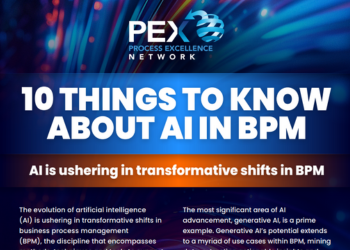The rapid evolution of artificial intelligence (AI) is driving significant transformations in business process management (BPM), presenting small and medium-sized businesses (SMBs) with opportunities to enhance efficiency, decision-making, and productivity. As AI and machine learning technologies become increasingly integrated into BPM solutions, they are revealing untapped potential that can redefine how SMBs operate. Recognizing this, industry trends indicate that many organizations are actively exploring the implementation of AI projects aimed at achieving operational excellence and empowering their transformation objectives.
According to the PEX Report 2024/25, a staggering 58 percent of businesses have initiated discussions around potential AI projects, signaling a strong willingness to incorporate innovative technologies to advance their capabilities. The report highlights AI as the primary investment focus for the upcoming year, with nearly half of organizations planning to allocate resources toward AI solutions. This widespread interest underscores a strategic shift where AI is not merely an optional enhancement but a core component of BPM strategies.
For SMBs contemplating the integration of AI into their BPM processes, the journey can begin by identifying specific operational pain points that AI can address. For instance, routine administrative tasks often consume valuable time and resources. By automating these repetitive workflows with AI-driven solutions, businesses can redirect talent toward higher-value activities. Consider a small marketing firm that utilizes AI to manage email campaigns. The technology can segment audiences, personalize messaging, and optimize send times, thereby allowing team members to focus on creative strategy and engagement rather than manual data management.
Moreover, AI can enhance decision-making capabilities by providing real-time insights based on data analysis. A small retail business can incorporate AI to analyze sales patterns, inventory levels, and customer preferences. Business leaders can leverage these insights to make more informed stock ordering decisions, ultimately resulting in higher customer satisfaction and reduced excess inventory costs. By integrating AI into the BPM framework, decision-makers can access predictive analytics that guide their strategies and responses to market fluctuations.
Another area where AI-driven workflows can bring substantial improvements is in customer service. Chatbots powered by AI can handle customer inquiries around the clock, offering quick responses to frequently asked questions while freeing human representatives to tackle more complex issues. A small tech support company that employs an AI chatbot can significantly improve response times and customer satisfaction rates while reducing operational costs. This type of automation not only enhances productivity but also reinforces customer loyalty through consistent, reliable service.
Furthermore, the role of AI in optimizing processes cannot be overstated. Businesses can leverage machine learning algorithms to streamline supply chain management, reducing waste and inefficiencies. For example, small manufacturing firms can implement AI solutions to monitor machinery performance and predict maintenance needs before failures occur. This proactive approach minimizes downtime and extends the lifecycle of equipment, resulting in considerable cost savings. Ultimately, the integration of AI fosters a culture of continuous improvement, whereby processes are consistently evaluated and refined.
From a return on investment (ROI) perspective, the financial implications of integrating AI into BPM workflows are noteworthy. While the initial investment in AI technology may seem daunting, the long-term savings and productivity gains can substantially outweigh these costs. Consider a small finance company that automates invoicing and payment processes with an AI solution. By eliminating manual errors and reducing processing times, the firm can realize faster cash flow and improved accuracy in financial reporting. This shift not only enhances operational efficiency but also contributes to strategic growth by enabling the company to invest in further innovations.
As SMBs embrace AI-driven BPM strategies, the collaboration between technology and human expertise will be crucial. While AI can handle data-driven tasks, the human element remains vital in interpreting insights and making final decisions. Leaders must cultivate a workplace culture that embraces technological advancement while also nurturing employee skill development. This balance ensures that employees feel empowered to leverage AI tools effectively, ultimately driving the organization toward its goals.
The convergence of AI and BPM is indeed creating a “perfect storm” filled with both opportunity and challenge for SMBs. As the landscape continues to evolve, organizations that proactively adopt AI solutions will be better positioned to navigate competitive markets and achieve sustainable success. By harnessing the power of automation and AI-driven workflows, businesses can unlock significant operational efficiencies, enhance decision-making processes, and improve overall productivity.
In summary, the integration of AI into business process management is not just a trend but a necessary strategic advantage for SMBs. By understanding how to implement AI-driven workflows and automation strategies effectively, organizations can empower their operations for future success. The path forward requires a thoughtful approach, focused on balancing technology with human insight to optimize workflows and foster innovation.
FlowMind AI Insight: Embracing AI in BPM is a transformative opportunity for SMBs to enhance efficiency and decision-making. By strategically integrating these technologies, businesses can unlock significant growth potential and position themselves competitively in the marketplace.
Original article: Read here
2024-10-16 07:00:00

